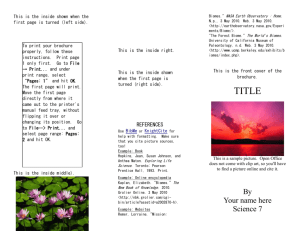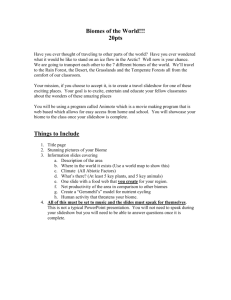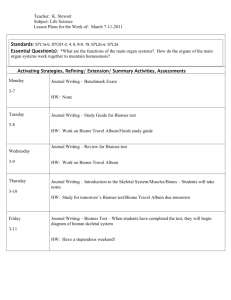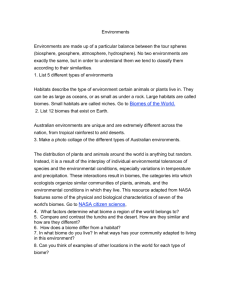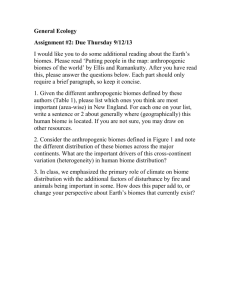Biomes & Biosphere Worksheet
advertisement
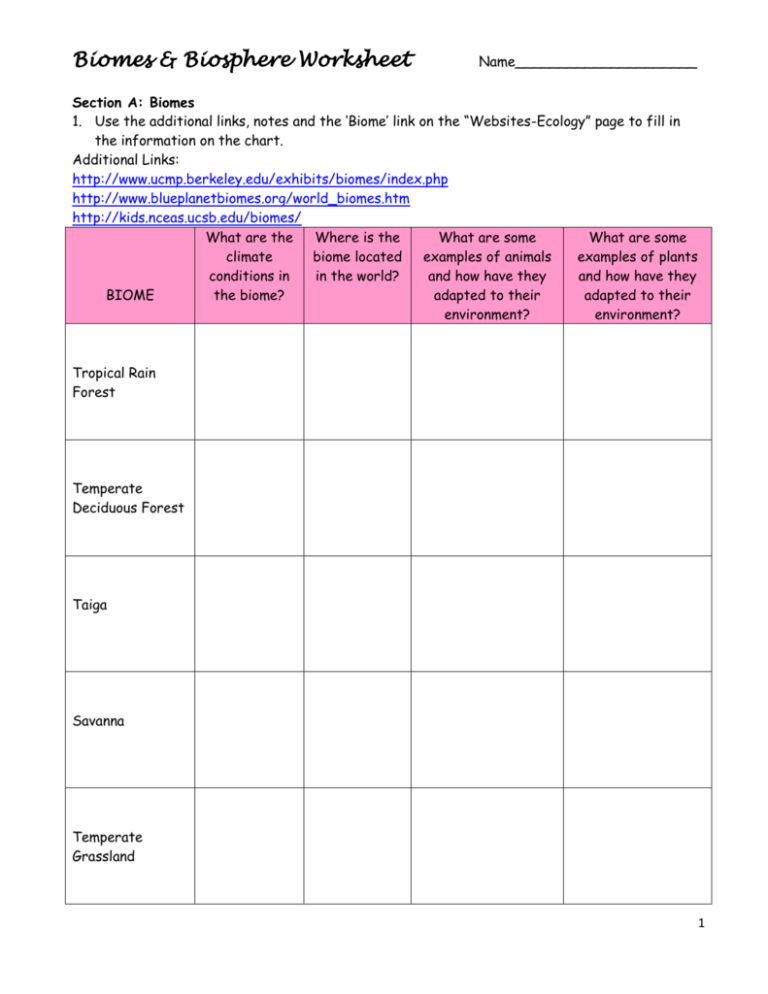
Biomes & Biosphere Worksheet Name_____________________ Section A: Biomes 1. Use the additional links, notes and the ‘Biome’ link on the “Websites-Ecology” page to fill in the information on the chart. Additional Links: http://www.ucmp.berkeley.edu/exhibits/biomes/index.php http://www.blueplanetbiomes.org/world_biomes.htm http://kids.nceas.ucsb.edu/biomes/ What are the Where is the What are some What are some climate biome located examples of animals examples of plants conditions in in the world? and how have they and how have they BIOME the biome? adapted to their adapted to their environment? environment? Tropical Rain Forest Temperate Deciduous Forest Taiga Savanna Temperate Grassland 1 Chaparral Desert Tundra Freshwater – lakes/ponds, wetlands, rivers Saltwater – wetlands, marshes/swamps, shores, reefs, oceans 2. What are some of the major threats to terrestrial biomes? 3. What are some of the major threats to aquatic biomes? 2 Section B: One Fish, Two Fish, NO Fish (Adapted from “Where River Meets Sea” Prentice Hall, Simon and Schuster Education Group (1996) Many estuary animals are well adapted to the normal changes of water temperature. Estuaries are areas where mixing between fresh water and sea water occur and some temperature fluctuations are normal. For example, the Chesapeake blue crab spends the winter months buried in the soft silt at the bottom of the deepest part of the bay. As summer approaches, crabs climb out of the mud and do about their important business of spawning and mating. On the west coast, the Dungeness crab buries itself in the sand to be protected from storms waves, but does not do well in warmer waters. If temperatures rise abnormally in a given summer, however, a certain number of less well-protected fish may suffocate. Temperature and Oxygen Levels When temperatures rise, the concentrations or levels of oxygen in the water fall because warmer water cannot hold as much dissolved oxygen. And when the level of oxygen falls below a certain point some fish are literally and figuratively “in hot water”. It is not the heat that threatens them directly, but the lack of oxygen, which they need to breathe. Scientists have been able to compare water temperatures and oxygen levels over time in order to determine their relationship. The table on this page shows reading taken in the Chesapeake Bay over a period of a year. Oxygen levels have been measured in parts per million, usually abbreviated as ppm. An oxygen reading of 10 ppm means that if a drop of water were divided into one million parts, 10 of those parts would consist of oxygen. By carefully watching how animals react to temperature and oxygen changes, biologists can determine when oxygen levels become uncomfortable – and when levels before so low that fish may die. Oxygen levels are best for fish when they measure above 6 parts per million (6 ppm or 6 mg/L). Levels from 3 to 5 ppm are uncomfortable, and levels below 3 ppm can cause death. Oxygen Levels in Chesapeake Bay Date Temperature (ºC) Oxygen Conc. (ppm) Jan 5 1 Jan 17 1 Feb 3 3 Feb 17 5 Mar 7 8 Mar 19 13 Apr 6 14 Apr 15 10 May 4 15 May 21 24 Jun 5 24 Jun 20 27 Jul 20 28 Aug 17 28 Sep 8 25 Sep 19 20 Oct 3 19 Oct 19 13 Nov 4 10 Nov 10 20 Dec 5 8 Analysis: Dec 4 1. What would happen if heated water suddenly enters the bay from an outside source? 20 could this happen? 13 12 13 11 11 9 11 9 7 8 7 6 6 4 6 7 7 10 5 10 12 12 How 3 2. Label the x axis and y axis. Plot the points and use a ruler to show the trend line. Use the data to answer the questions below. 3. Discuss how you think oxygen levels in an estuary might be likely to rise or fall during a cold spell. 4. How would climate change affect oxygen levels and organism in aquatic biomes? 5. What do you notice about the change in temperature and oxygen concentration? 4 Section C: Environmental Issues – Land Resources 1. What’s the difference between renewable and nonrenewable resources? List examples of each. As you watch the video clip, answer the questions below. http://www.youtube.com/watch?v=cNBFcD0GQYY (deforestation/climate change) 2. What are some of the negative effects of deforestation? 3. How does deforestation impact the water and carbon cycles? As you watch the video clip, answer the questions below. http://www.youtube.com/watch?v=K23D3wbUt3k (desertification) 4. What processes lead to desertification? 5. What are the negative effects of desertification? Section D: Environmental Issues – Water & Air Resources 1. List 2 human activities that affect water resources, and explain the changes that can result. 2. List 2 human activities that affect air resources, and explain the changes that can result. 5 As you watch the video clip, answer the questions below. http://channel.nationalgeographic.com/channel/videos/acid-rain-invisible-menace/ (acid rain) 3. What are the negative effects of acid rain in the Appalachians? Section E: Biodiversity 1. Define biodiversity. 2. Why are keystone species important for ecosystems? 3. What is habitat fragmentation? Provide an example. 4. Canadian Geese have long been a migratory champion of the eastern part of the North American continent. Each year they would migrate from the summer home in Canada to their winter grounds in the Deep South. This pattern has been disrupted over the last decade however. It is not uncommon for the geese to remain in one location, feeding off the land, year round. They are particularly plentiful in residential developments and on golf courses. The numbers of non-migratory geese have grown to the point of their becoming a nuisance in many suburban areas. a. What new environmental conditions exist now that allows the geese not to migrate? b. How might other organisms here be affected by the geese not migrating? On the ‘Websites-Ecology’ page, click on ‘Conservation Issues’…..answer the questions. 5. There are several threats in the U.S. that have reduced wildlife. List the 7 ‘Threats to Wildlife’. 6 6. Click on ‘Invasive Species’ and answer these questions. A. What are invasive species? B. How do invasive species spread? C. Why do invasive species pose such a threat? D. List 4 examples of invasive species in the U.S. E. How can global warming influence invasive species activity? 7. What is biological magnification? 8. Explain how biological magnification occurs. 9. In a food chain, which organism has the greatest concentration of chemicals? 7 Section F: Ozone & Greenhouse Effect 1. What is the function of the ozone gas? 2. Describe the process by which chlorofluorocarbons deplete the ozone layer. Need more help understanding the Ozone….go to the ‘Websites-Ecology’ page and click on ‘Ozone’. 3. What is the greenhouse effect and why is it important to life on Earth? 4. What are the main contributors of greenhouse gases? 5. What impact has global warming had on Earth? Need more help understanding Global Warming and the Greenhouse Effect….go to ‘Websites- Ecology’ page and click on ‘Global Warming’. 8



